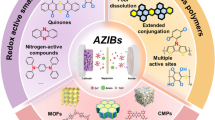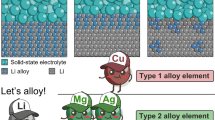Abstract
The potential application of high-capacity Sn4P3 anode for potassium-ion batteries (PIBs) is hindered by the poor cycle stability mainly rooted from the huge volume changes upon cycling and low electronic conductivity. To address the above issues, sandwich-like structured Sn4P3/Ti3C2Tx was designed and synthesized as anode material for PIBs. As a result, Sn4P3/Ti3C2Tx presents superior cycle stability (retains a capacity of 103.2 mAh·g−1 even after 300 cycles at 1000 mA·g−1) and rate capability (delivers 60.7 mAh·g−1 at high current density of 2000 mA·g−1). The excellent electrochemical performance of sandwich-like structured Sn4P3/Ti3C2Tx is originated from the synergistic effect between Sn4P3 and Ti3C2Tx, where Ti3C2Tx acts as a conductive matrix to facilitate electron transfer and buffer the volume change of Sn4P3 particles upon cycling, while Sn4P3 serves as pillars to prevent the collapse and stacking of Ti3C2Tx sheets. Moreover, significant capacitive contribution is demonstrated as a major contributor to the excellent rate capability.
Graphical abstract

摘要
作为钾离子电池 (PIB)负极材料, Sn4P3具有较高的储钾容量。然而, 充放电过程中材料发生的巨大的体积变化和较低的电子电导率导致其循环稳定性较差, 阻碍了其实际应用。为了解决上述问题, 本文设计并制备了三明治结构的Sn4P3/Ti3C2Tx 复合材料, 并对其储钾性能进行了研究。研究结果显示, Sn4P3/Ti3C2Tx复合电极具有优越的循环稳定性能 (在 1000 mA·g−1电流密度下循环 300 次后仍保持103.2 mAh·g−1 的容量) 和倍率性能 (在 2000 mA·g−1 的高电流密度下容量可达到 60.7 mAh·g−1)。Sn4P3/Ti3C2Tx复合材料的优异的电化学性能来源于Sn4P3和Ti3C2Tx 之间的有效协同作用: Ti3C2Tx作为导电骨架, 促进了电子转移, 并缓冲了循环过程中Sn4P3颗粒的体积变化; Sn4P3作为支柱, 防止了Ti3C2Tx片的倒塌和堆积。此外, 显著的电容行为是Sn4P3/Ti3C2Tx倍率性能优异的主要原因之一。







Similar content being viewed by others
References
Chu S, Majumdar A. Opportunities and challenges for a sustainable energy future. Nature. 2012;488(7411):294.
Dunn B, Kamath H, Tarascon JM. Electrical energy storage for the grid: a battery of choices. Science. 2011;334(6058):928.
Xia MT, Chen BJ, Gu F, Zu LH, Xu MZ, Feng YT, Wang ZJ, Zhang HJ, Zhang C, Yang JH. Ti3C2Tx MXene nanosheets as a robust and conductive tight on si anodes significantly enhance electrochemical lithium storage performance. ACS Nano. 2020;14(4):5111.
Xiong PX, Wu JX, Zhou MF, Xu YH. Bismuth-antimony alloy nanoparticle@porous carbon nanosheet composite anode for high-performance potassium-ion batteries. ACS Nano. 2020;14(1):1018.
Zhou JH, Guo SJ. Carbon-based anode materials for potassium-ion batteries: From material, mechanism to performance. SmartMat. 2021;2(2):176.
Liang JM, Zhang LJ, Xili DG, Kang J. Research progress on tin-based anode materials for sodium ion batteries. Rare Met. 2020;39(9):1005.
Zhou MF, Bai PX, Ji X, Yang JX, Wang CS, Xu YH. Electrolytes and interphases in potassium ion batteries. Adv Mater. 2021;33(7):e2003741.
Li X, Qi SH, Zhang WC, Feng YZ, Ma JM. Recent progress on FeS2 as anodes for metal-ion batteries. Rare Met. 2020;39(11):1239.
Qi SH, Deng JW, Zhang WC, Feng YZ, Ma JM. Recent advances in alloy-based anode materials for potassium ion batteries. Rare Met. 2020;39(9):970.
Ma JM, Li YT. Editorial for advanced energy storage and conversion materials and technologies. Rare Met. 2020;39(9):967.
Zhang WC, Pang WK, Sencadas V, Guo ZP. Understanding high-energy-density Sn4P3 anodes for potassium-ion batteries. Joule. 2018;2(8):1534.
Zhang WC, Mao JF, Li S, Chen ZX, Guo ZP. Phosphorus-based alloy materials for advanced potassium-ion battery anode. J Am Chem Soc. 2017;139(9):3316.
Lei KX, Wang J, Chen C, Li SY, Wang SW, Zheng SJ, Li FJ. Recent progresses on alloy-based anodes for potassium-ion batteries. Rare Met. 2020;39(9):989.
Li DP, Zhang YM, Sun Q, Zhang SN, Wang ZP, Liang Z, Si PC, Ci LJ. Hierarchically porous carbon supported Sn4P3 as a superior anode material for potassium-ion batteries. Energy Storage Mater. 2019;23:367.
Ran LB, Gentle I, Lin TE, Luo B, Mo N, Rana M, Li M, Wang LZ, Knibbe R. Sn4P3@porous carbon nanofiber as a self-supported anode for sodium-ion batteries. J Power Sources. 2020;461:228116.
Wang WH, Zhang JL, Yu DYW, Li Q. Improving the cycling stability of Sn4P3 anode for sodium-ion battery. J Power Sources. 2017;364:420.
Zhang JL, Li CL, Wang WH, Yu DYW. Facile synthesis of hollow Cu3P for sodium-ion batteries anode. Rare Met. 2021;40(12):3460.
Qian JF, Xiong Y, Cao YL, Ai XP, Yang HX. Synergistic Na-storage reactions in Sn4P3 as a high-capacity, cycle-stable anode of Na-ion batteries. Nano Lett. 2014;14(4):1865.
Liu SL, Zhang HZ, Xu LQ, Ma LB. Synthesis of hollow spherical tin phosphides (Sn4P3) and their high adsorptive and electrochemical performance. J Crystal Growth. 2016;438:31.
Zhang JL, Wang WH, Li BH. Effect of particle size on the sodium storage performance of Sn4P3. J Alloys and Compounds. 2019;771:204.
Meng RJ, Deng QY, Peng CX, Chen BJ, Liao KX, Li LJ, Yang ZY, Yang DL, Zheng L, Zhang C, Yang JH. Two-dimensional organic-inorganic heterostructures of in situ-grown layered COF on Ti3C2 MXene nanosheets for lithium-sulfur batteries. Nano Today. 2020;35:100991.
Meng RJ, Huang JM, Feng YT, Zu LH, Peng CX, Zheng LR, Zheng L, Chen ZB, Liu GL, Chen BJ, Mi YL, Yang JH. Black phosphorus quantum dot/Ti3C2 MXene nanosheet composites for efficient electrochemical lithium/sodium-ion storage. Adv Energy Mater. 2018;8(26):1801514.
Ming FW, Liang HF, Huang G, Bayhan Z, Alshareef HN. MXenes for rechargeable batteries beyond the lithium-ion. Adv Mater. 2021;33(1):2004039.
Kajiyama S, Szabova L, Sodeyama K, Iinuma H, Morita R, Gotoh K, Tateyama Y, Okubo M, Yamada A. Sodium-ion intercalation mechanism in MXene nanosheets. ACS Nano. 2016;10(3):3334.
Li K, Liang MY, Wang H, Wang XH, Huang YS, Coelho J, Pinilla S, Zhang YL, Qi FW, Nicolosi V, Xu YX. 3D MXene architectures for efficient energy storage and conversion. Adv Funct Mater. 2020;30(47):2000842.
Zhao DY, Zhao RZ, Dong SH, Miao XG, Zhang ZW, Wang CX, Yin LW. Alkali-induced 3D crinkled porous Ti3C2 MXene architectures coupled with NiCoP bimetallic phosphide nanoparticles as anodes for high-performance sodium-ion batteries. Energy Environ Sci. 2019;12(8):2422.
Hui XB, Zhao RZ, Zhang P, Li CX, Wang CX, Yin LW. Low-temperature reduction strategy synthesized Si/Ti3C2 MXene composite anodes for high-performance Li-ion batteries. Adv Energy Mater. 2019;9(33):1901065.
Li JH, Rui BL, Wei WX, Nie P, Chang LM, Le ZY, Liu MQ, Wang HR, Wang LM, Zhang XG. Nanosheets assembled layered MoS2/MXene as high performance anode materials for potassium ion batteries. J Power Sources. 2020;449:227481.
Zhao TK, Zhang JK, Du Z, Liu YH, Zhou GL, Wang JT. Dopamine-derived N-doped carbon decorated titanium carbide composite for enhanced supercapacitive performance. Electrochim Acta. 2017;254:308.
Pan ZH, Cao F, Hu X, Ji XH. A facile method for synthesizing CuS decorated Ti3C2 MXene with enhanced performance for asymmetric supercapacitors. J Mater Chem A. 2019;7(15):8984.
Guo X, Zhang WX, Zhang JQ, Zhou D, Tang X, Xu XF, Li BH, Liu H, Wang GX. Boosting sodium storage in two-dimensional phosphorene/Ti3C2Tx MXene nanoarchitectures with stable fluorinated interphase. ACS Nano. 2020;14(3):3651.
Pan E, Jin YH, Zhao CC, Jia M, Chang QQ, Jia MQ. Dopamine-derived N-doped carbon encapsulating hollow Sn4P3 microspheres as anode materials with superior sodium storage performance. J Alloys Compd. 2018;769:45.
Liu YT, Zhang P, Sun N, Anasori B, Zhu QZ, Liu H, Gogotsi Y, Xu B. Self-assembly of transition metal oxide nanostructures on MXene nanosheets for fast and stable lithium storage. Adv Mater. 2018;30(23):e1707334.
Li H, Chen R, Ali M, Lee H, Ko MJ. In situ grown MWCNTs/MXenes nanocomposites on carbon cloth for high-performance flexible supercapacitors. Adv Funct Mater. 2020;30(47):2002739.
Ran LB, Luo B, Gentle IR, Lin TE, Sun Q, Li M, Rana MM, Wang LZ, Knibbe R. Biomimetic Sn4P3 anchored on carbon nanotubes as an anode for high-performance sodium-ion batteries. ACS Nano. 2020;14(7):8826.
Liu Q, Ye JJ, Chen ZZ, Hao Q, Xu CX, Hou JG. Double conductivity-improved porous Sn/Sn4P3@carbon nanocomposite as high performance anode in lithium-ion batteries. J Colloid Interface Sci. 2019;537:588.
Fan L, Ma RF, Wang J, Yang HG, Lu BA. An ultrafast and highly stable potassium-organic battery. Adv Mater. 2018;30(51):e1805486.
Huang KS, Xing Z, Wang LC, Wu X, Zhao W, Qi XJ, Wang H, Ju ZC. Direct synthesis of 3D hierarchically porous carbon/Sn composites via in situ generated NaCl crystals as templates for potassium-ion batteries anode. J Mater Chem A. 2018;6(2):434.
Wang H, Xing Z, Hu ZK, Zhang Y, Hu Y, Sun YW, Ju ZC, Zhuang QC. Sn-based submicron-particles encapsulated in porous reduced graphene oxide network: advanced anodes for high-rate and long life potassium-ion batteries. Appl Mater Today. 2019;15:58.
Zhao XX, Wang WH, Hou Z, Wei GJ, Yu YK, Zhang J, Quan Z. SnP0.94 nanoplates/graphene oxide composite for novel potassium-ion battery anode. Chem Eng J. 2019;370:677.
Acknowledgments
This work was financially supported by the National Natural Science Foundation of China (No. 52100084) and Shenzhen Natural Science Fund (No. GXWD20201230155427003-20200824094017001).
Author information
Authors and Affiliations
Corresponding authors
Ethics declarations
Conflict of interests
The authors declare that they have no conflict of interest.
Supplementary Information
Below is the link to the electronic supplementary material.
Rights and permissions
About this article
Cite this article
Zhao, J., Li, CL., Chen, G. et al. Rational design of Sn4P3/Ti3C2Tx composite anode with enhanced performance for potassium-ion battery. Rare Met. 41, 2259–2267 (2022). https://doi.org/10.1007/s12598-021-01934-7
Received:
Revised:
Accepted:
Published:
Issue Date:
DOI: https://doi.org/10.1007/s12598-021-01934-7




